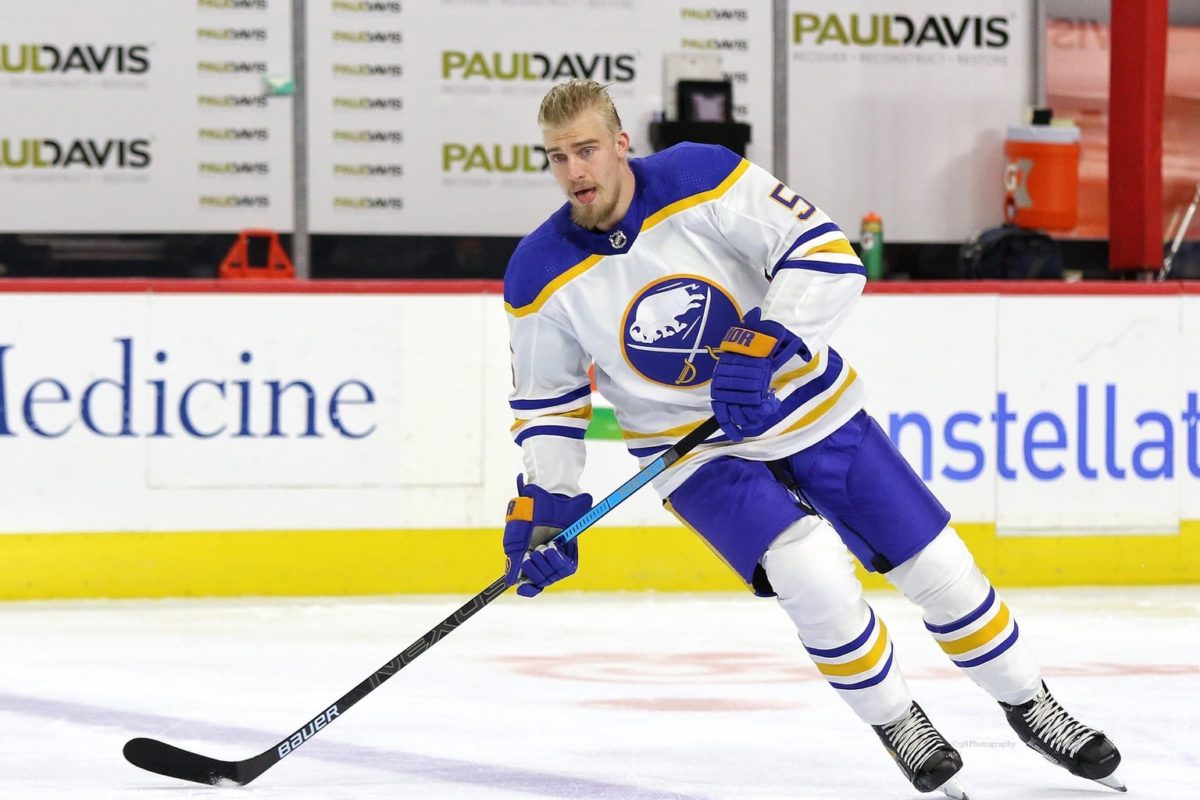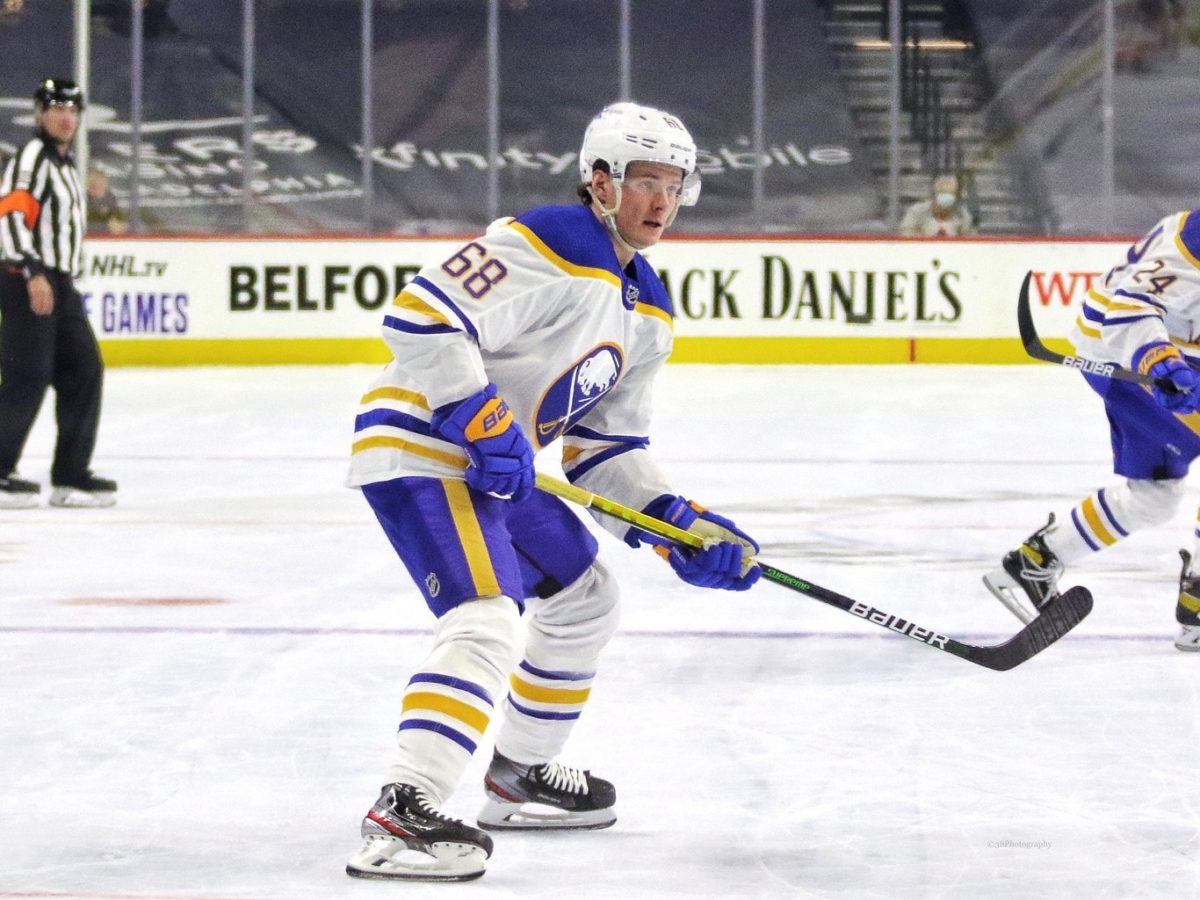If there’s one word to describe the Buffalo Sabres’ first six games of the 2020-21 season, it’s “inconsistent.” Despite playing well in nearly every game, the Sabres find themselves at just 2-3-1 in the early going.
The team isn’t getting goalscoring from some of their stars — Jack Eichel, Taylor Hall, Jeff Skinner, and Rasmus Dahlin have one goal between the four of them — and the goaltending has been an issue, as many predicted before the season.
But the Sabres have also gotten contributions from some of the less-heralded names on both offense and defense. They’ve also weathered a brutal early schedule that saw them play the first-place Washington Capitals four times in 10 days, as well as two games against a talented Philadelphia Flyers squad. The schedule appears to ease up this coming week with four straight at home against the New York Rangers (Tuesday and Thursday) and New Jersey Devils (Saturday and Sunday).
As the Sabres continue to find their footing in the early part of this shortened season, let’s take a look at some of the players who have been pleasant surprises and frustrating disappointments to this point.
Surprise: Jake McCabe
After Buffalo upgraded its forward group in the offseason, there were plenty of questions left regarding a blue line that remained unchanged from the uninspiring unit of 2019-20. One of those question marks involved veteran Jake McCabe, but so far this season, the American blueliner has been one of head coach Ralph Krueger’s most reliable players.
The counting numbers won’t blow you away: one goal, two points, a plus-2 rating. But McCabe has been a rock in his own end, playing exceptionally well at 5-on-5 with partner Rasmus Ristolainen.
McCabe doesn’t get a ton of work on special teams, as evidenced by his 18:50 average time-on-ice, and he is never going to be a real threat in the offensive zone. But as long as he continues to do solid work at even strength — the most important part of the game — the Sabres will continue to reap the benefits.
Disappointment: Rasmus Dahlin
Expectations were sky-high for the former number one pick entering his pivotal third season. It’s early, of course, but Dahlin has been a liability more than an asset in nearly every game this season. The 20-year-old has yet to find the score sheet and boasts a team-worst minus-5 rating.
It’s been more than just the lack of production, however. Dahlin’s made a number of very noticeable mistakes, including a disastrous outing in Friday’s shootout loss to Washington when he was directly involved in two Capitals goals and made another error that very nearly led to a shorthanded goal. Krueger took notice, sitting Dahlin for a good portion of that game.
Again, it’s important to remember just how young Dahlin still is and how much better he is likely to get. There’s every reason to believe he’s going to become a franchise defenseman. But the early portion of this season has provided some of his biggest growing pains so far.
Surprise: Rasmus Ristolainen
A lot of what was said about McCabe applies to his partner Ristolainen. Long a lightning rod for debate among Sabres fans, the big Finn has played some of his best hockey in these first six games.

The analytics community has long been among Ristolainen’s most vocal critics, but his advanced numbers have been absolutely sensational so far. Per MoneyPuck, his on-ice expected goals for per 60 Minutes (xGF/60) of 2.18 dwarfs his expected goals against (xGA/60) of 1.13. His Corsi numbers are similarly excellent: 52.42 on-ice shot attempts for per 60 Minutes compared to 38.91 against.
The traditional numbers read well, too, as Ristolainen has three points and a team-best plus-4 rating while playing more than 22 minutes a night (22:17). Krueger seems to have found the sweet spot of how much ice time Ristolainen sees. Until something changes, the strategy should remain the same moving forward.
Disappointment: Linus Ullmark
It’s been a trying season already for Ullmark. The Swedish netminder was a late arrival to training camp and then had to deal with the passing of his father.
With that said, the Sabres will need more from their number one goalie. With Carter Hutton’s struggles continuing (.899% save percentage (SV%) in three games), Ullmark has to prove he can be a reliable presence. The early returns have been mixed, to say the least.
Ullmark sports a .905% SV% and 2.55 goals against average (GAA), numbers that place him at 32nd and 24th in the NHL, respectively. But the problem often hasn’t been simply that he’s allowing goals; it’s the timing and types of goals he’s letting in. Far too often, the Sabres score a goal, only to let one in minutes later. And they’re usually not highlight-reel goals, either: in Sunday’s shootout win over Washington, Nicklas Backstrom scored the tying goal by banking the puck in off of an out-of-position Ullmark into the net.
He did recover to stop the Caps in the shootout to get his first win of the season, but Ullmark needs to find some consistency if the Sabres are to have any chance to remain in the postseason conversation.
Surprise: Curtis Lazar
The additions of Hall and Eric Staal made the headlines this offseason, and both have played well early on (Hall has six points, Staal has three). Their additions to an already-talented top-six still left questions as to who would provide contributions from the bottom-six. One of those players who has made an impact early on has been Curtis Lazar.

The 25-year-old already has two goals, and as mentioned earlier, that’s more than some of the team’s marquee names. While he’s only averaging 11:47 of ice time per game, he’s been a reliable presence on the penalty kill and can be counted on to provide a rush of energy whenever he steps on the ice.
Buffalo doesn’t need big offensive numbers from Lazar. On a team with a lot of flashy forwards, it needs him to continue to make the unflashy plays that help win games.
Disappointment: Victor Olofsson
It might seem crazy to list a player with three goals and five points in six games as a disappointment. But if you delve deeper into the numbers, you’ll discover some troubling trends in Olofsson’s play.
For one thing, all three of those goals have come on the power play. While Olofsson is obviously a weapon with the man advantage, he hasn’t done much in the way of 5-on-5 scoring.

The advanced numbers bear that out: Olofsson’s xGF/60 of 1.64 is markedly lower than his xGA/60 of 2.14. His Corsi numbers are even worse, with 41.29 shot Attempts for per 60 as opposed to 54.81 against.
This isn’t to say that Olofsson has been bad through the first six games; after all, his five points are third on the team. But he also boasts a minus-4 rating and has left a lot to be desired with his two-way game. There’s plenty of time for improvement, but this is an instance when the basic numbers don’t tell the whole story.
While it seems like the season just started, the Sabres are already through more than 10 percent of their regular-season schedule. It’s a small sample size, but there are some trends that have emerged that worth keeping an eye on. This includes whether the players detailed above continue their current run of play or turn things in the opposite direction — for better or worse.